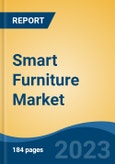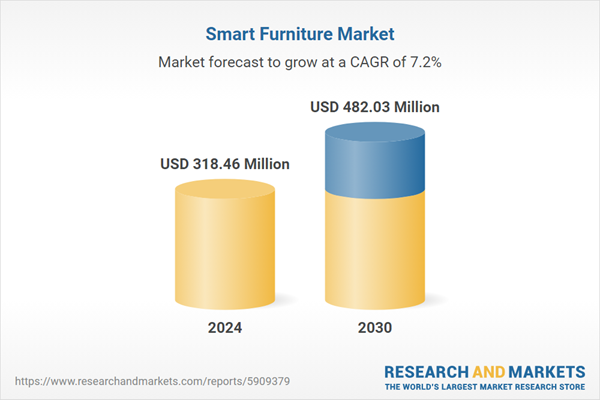Speak directly to the analyst to clarify any post sales queries you may have.
10% Free customizationThis report comes with 10% free customization, enabling you to add data that meets your specific business needs.
Additionally, advancements in IoT and AI are enabling personalized user experiences. The market is further supported by expanding disposable incomes, evolving lifestyles, and increasing emphasis on connected and sustainable living. According to the United Nations, as of 2024, 57.9% of the global population resides in urban areas, highlighting growing urbanization and the need for space-efficient, multifunctional home solutions.
Key Market Drivers
Rising Adoption of Smart Homes and IoT Integration
The increasing adoption of smart homes is a major driver of the smart furniture market. As consumers embrace connected living environments, demand for furniture embedded with IoT-enabled features such as wireless charging, Bluetooth speakers, and app-controlled adjustments continues to grow. Smart furniture seamlessly integrates into modern smart home ecosystems, allowing users to control lighting, temperature, and entertainment from multifunctional furniture pieces.For instance, beds with sleep-tracking sensors or smart desks that adjust height automatically enhance convenience while aligning with broader smart home trends. The rising penetration of voice assistants like Amazon Alexa, Google Assistant, and Apple Siri further fuels adoption. Consumers are now seeking furniture that not only offers comfort but also synchronizes with their digital lifestyle, making IoT-enabled smart furniture an attractive choice. Additionally, the growing awareness of energy efficiency and automation is pushing both residential and commercial users toward furniture that maximizes comfort while optimizing functionality.
Key Market Challenges
High Cost and Affordability Issues
One of the most significant challenges limiting the growth of the smart furniture market is the high cost associated with these products. Unlike traditional furniture, smart furniture incorporates advanced technologies such as IoT, AI, sensors, and connectivity modules, which substantially increase production costs. This often results in a premium price tag, making such furniture less accessible to middle- and lower-income consumers. While high-income groups in developed regions can afford to invest in these products, affordability remains a critical concern in emerging markets where price sensitivity is higher.Consumers often hesitate to purchase smart furniture due to the perception that its benefits do not justify the elevated price compared to conventional options. Additionally, frequent technological advancements lead to shorter product life cycles, discouraging buyers from investing heavily in furniture that may quickly become outdated. The lack of mass production and limited economies of scale further contribute to high prices, creating a barrier to widespread adoption. Until manufacturers can optimize production processes and reduce costs, affordability will remain a pressing challenge.
Key Market Trends
Rising Demand for Ergonomic and Health-Focused Solutions
The growing awareness of health and wellness, particularly in the context of home and workplace environments, is driving demand for ergonomic smart furniture. With the rise of remote and hybrid work models, consumers are increasingly investing in smart desks, chairs, and workstations designed to improve comfort and support long hours of usage. Features such as automatic height adjustment, posture correction sensors, and reminders to move are becoming highly attractive to health-conscious buyers.Smart beds that monitor sleep quality, track vital signs, and suggest improvements have also gained popularity among consumers who prioritize wellness. This trend is particularly visible in the corporate sector, where employers are adopting ergonomic smart furniture to enhance employee productivity and reduce health-related issues. Additionally, the integration of health monitoring features with smartphones and wearable devices is allowing consumers to manage their well-being holistically. As awareness about musculoskeletal health, chronic fatigue, and lifestyle-related disorders continues to rise, health-focused smart furniture is emerging as one of the most influential trends in the market.
Key Market Players
- Inter Ikea Systems B.V.
- StoreBound LLC
- MillerKnoll, Inc. (Herman Miller)
- Sleep Number Corporation
- Hi-Interiors srl
- Modoola Limited
- Desktronik
- Nitz Engineering GmbH
- Fonesalesman, LLC
- Wayfair Inc
Report Scope:
In this report, the Global Smart Furniture Market has been segmented into the following categories, in addition to the industry trends which have also been detailed below:Smart Furniture Market, By Type:
- Smart Table
- Smart Desks
- Smart Chairs
- Others
Smart Furniture Market, By Application:
- Residential
- Commercial
Smart Furniture Market, By Distribution Channel:
- Offline
- Online
Smart Furniture Market, By Region:
- North America
- United States
- Canada
- Mexico
- Europe
- France
- United Kingdom
- Italy
- Germany
- Spain
- Asia-Pacific
- China
- Japan
- India
- South Korea
- Indonesia
- South America
- Argentina
- Colombia
- Brazil
- Middle East & Africa
- South Africa
- Saudi Arabia
- UAE
- Turkey
Competitive Landscape
Company Profiles: Detailed analysis of the major companies present in the Global Smart Furniture Market.Available Customizations:
With the given market data, the publisher offers customizations according to a company's specific needs. The following customization options are available for the report.Company Information
- Detailed analysis and profiling of additional market players (up to five).
This product will be delivered within 1-3 business days.
Table of Contents
Companies Mentioned
- Inter Ikea Systems B.V.
- StoreBound LLC
- MillerKnoll, Inc. (Herman Miller)
- Sleep Number Corporation
- Hi-Interiors srl
- Modoola Limited
- Desktronik
- Nitz Engineering GmbH
- Fonesalesman, LLC
- Wayfair Inc
Table Information
| Report Attribute | Details |
|---|---|
| No. of Pages | 181 |
| Published | September 2025 |
| Forecast Period | 2024 - 2030 |
| Estimated Market Value ( USD | $ 318.46 Million |
| Forecasted Market Value ( USD | $ 482.03 Million |
| Compound Annual Growth Rate | 7.1% |
| Regions Covered | Global |
| No. of Companies Mentioned | 10 |









